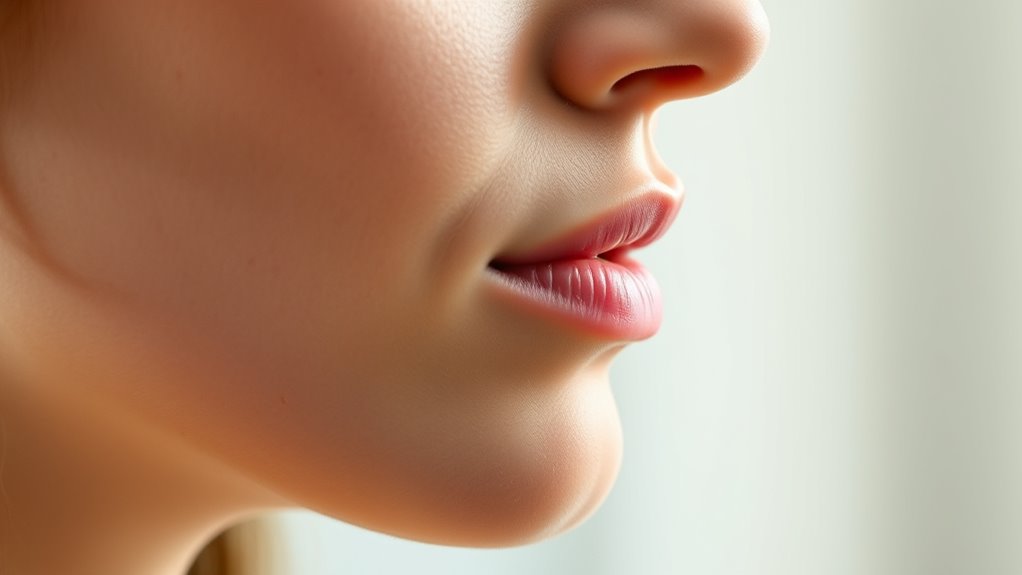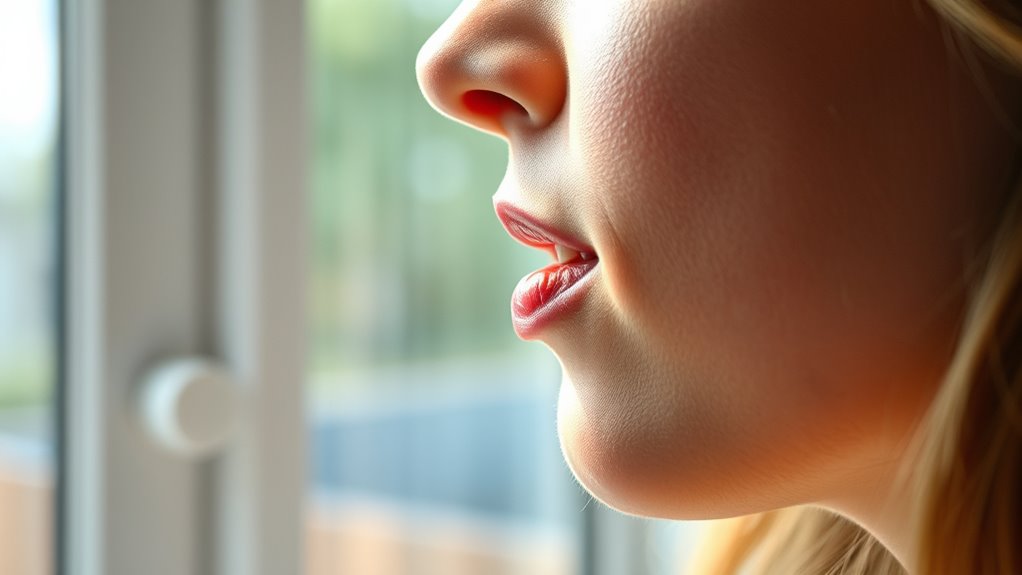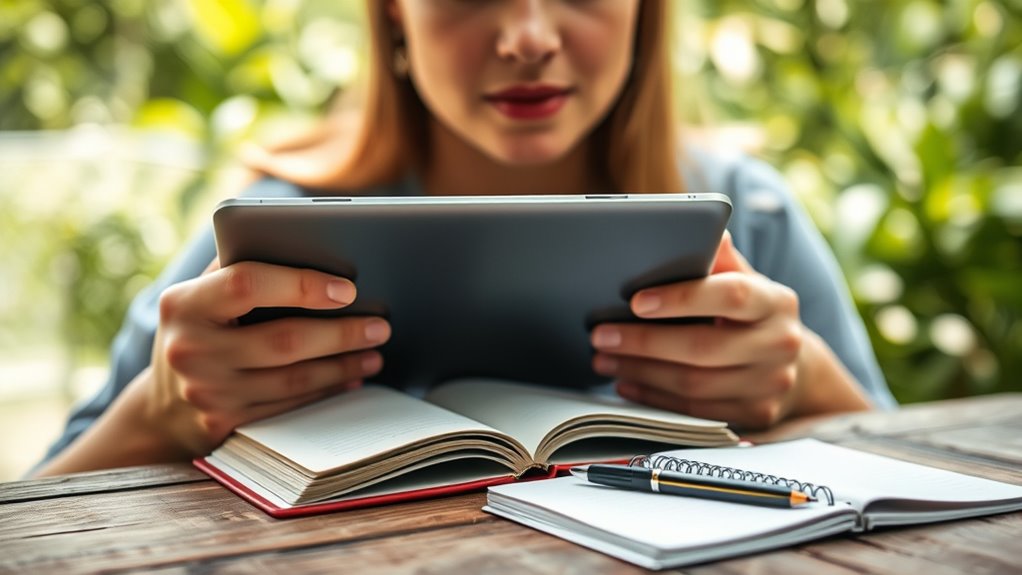To master lip-reading anywhere, focus on recognizing basic lip movements and speech patterns. Practice observing lip shapes, facial expressions, and gestures in different environments, even noisy ones. Use apps and online videos to enhance your skills, replaying tricky segments. Track your progress by recording yourself and practicing regularly with diverse speakers. By consistently paying attention to visual cues and emotional signals, you’ll improve your accuracy—and if you keep exploring, you’ll discover even more techniques to sharpen your skills.
Key Takeaways
- Practice recognizing lip shapes, movements, and facial cues in various environments, including noisy settings.
- Use mobile apps and online videos with replay features to reinforce visual speech recognition skills.
- Record and analyze your own lip movements and expressions to track progress and improve accuracy.
- Incorporate gestures and emotional cues alongside lip movements for better comprehension.
- Engage in daily exercises with diverse speakers to adapt to different lip patterns and enhance confidence.
Understanding Basic Lip Movements

To effectively master lip-reading, you need to start by understanding basic lip movements. This begins with grasping articulatory phonetics—the study of how speech sounds are produced through speech articulation. When someone speaks, their lips, tongue, and jaw work together to form distinct shapes that correspond to specific sounds. By observing these lip movements, you can begin to associate particular shapes with certain words or sounds. Focus on how the lips come together, part, or move in different ways during speech. Recognizing these subtle movements helps you decode spoken words more accurately. Developing this foundational knowledge of speech articulation allows you to improve your lip-reading skills and become more confident in understanding conversations, even when hearing is limited. Additionally, understanding the contrast between different speech sounds can greatly enhance your ability to distinguish similar-looking lip movements.
Recognizing Common Speech Patterns

Recognizing common speech patterns is essential for improving your lip-reading skills because it allows you to identify recurring visual cues in conversation. Speech often follows predictable patterns, like common phrases or sentence structures, which can help you anticipate words. Pay attention to auditory cues, such as pauses or emphasis, that hint at what’s coming next. Contextual clues also play a crucial role; understanding the situation or topic helps narrow down possible words. For example, if someone talks about food, your mind can filter out unrelated words. Over time, noticing these patterns makes it easier to fill in gaps when visual information is unclear. Recognizing speech patterns and how they influence conversation flow can significantly boost your understanding. By combining visual cues with auditory cues and context, you enhance your ability to accurately interpret conversations.
Practicing in Noisy Environments

Practicing lip-reading in noisy environments challenges you to focus on visual cues when auditory information is unclear or distorted. Background noise makes it harder to hear speech, so you rely more on lip movements and facial expressions. To improve, try practicing in places with varying levels of background noise, such as cafes or busy streets. Pay attention to how speaker distance affects visibility; the farther the speaker, the harder it is to see their lips clearly. Adjust your focus accordingly, and practice tracking lip movements from different distances. This helps you become more adept at deciphering speech in real-world situations where noise and distance often hinder hearing. Consistent practice in such environments sharpens your skills and boosts your confidence in understanding speech visually. Incorporating emotional triggers into your practice can also enhance your ability to interpret subtle facial cues and expressions.
Using Visual Cues to Improve Comprehension

To enhance your lip-reading skills, focus on the movements of the speaker’s lips and mouth. Pay close attention to facial expressions, as they add important context. Also, eliminate distractions to better observe these visual cues and improve your understanding. Recognizing recurring visual patterns can further aid in identifying common speech cues and enhance your decoding abilities.
Focus on Lip Movements
By paying close attention to lip movements, you can substantially enhance your understanding of spoken words, especially in noisy environments or when audio quality is poor. Focus on how the lips articulate sounds, guided by articulatory phonetics, and notice the tension in facial muscles during speech. Visual cues like lip shape, movement speed, and jaw position reveal key phonetic details. To visualize this, imagine:
| Lip Shape | Sound Produced |
|---|---|
| Rounded, protruded | /o/ as in “go” |
| Narrow, stretched | /i/ as in “see” |
| Open, relaxed | /a/ as in “father” |
| Pursed lips | /p/ or /b/ sounds |
Additionally, practicing lip-reading exercises can help train your visual decoding skills and improve overall comprehension.
Observe Facial Expressions
Paying attention to facial expressions enhances your ability to interpret spoken words beyond lip movements alone. Facial microexpressions and emotional cues reveal feelings and intentions that words may not express. To improve your understanding, focus on:
- Recognizing facial microexpressions that signal emotions like surprise, anger, or confusion.
- Observing subtle changes in eye contact, brow movements, and mouth tension for emotional cues.
- Connecting these cues with context to better interpret what’s being communicated.
- Understanding the importance of nonverbal communication in conveying message nuances beyond spoken language.
Minimize Distractions
Distractions can considerably hinder your ability to interpret speech through lip-reading, but focusing on visual cues helps you stay engaged and improve comprehension. Minimize environmental factors that divert your attention, such as noise or movement, and enhance your situational awareness. By creating a quiet, well-lit environment, you reduce visual clutter and make it easier to focus on the speaker’s lips and facial expressions. Developing attention skills can further boost your ability to concentrate during practice sessions.
Daily Exercises to Strengthen Lip-Reading Skills

To effectively improve your lip-reading skills, incorporating daily exercises can make a significant difference. One effective method is gesture training, where you practice recognizing common hand and body gestures associated with conversations. Additionally, facial expression analysis helps you interpret emotions and contextual clues, enhancing understanding. To get started, try these exercises:
Enhance lip-reading by practicing gestures and facial expressions daily for better understanding.
- Practice observing speakers’ gestures and matching them to words or phrases.
- Focus on facial expressions to infer emotions and intent during conversations.
- Record short videos of yourself speaking, then analyze your lip movements alongside gestures and expressions.
- Understanding legal guidelines related to communication and non-verbal cues can further refine your interpretative skills.
Consistent practice sharpens your ability to interpret visual cues, making your lip-reading skills more accurate and confident. These exercises can be done anywhere, anytime, with minimal equipment.
Incorporating Technology and Resources

Using technology can considerably enhance your lip-reading practice. Mobile apps and online videos provide convenient, engaging ways to improve your skills anytime. Exploring these resources helps you stay consistent and motivated in your learning journey. Incorporating essential oils into your environment may also improve focus and relaxation during practice sessions.
Mobile Apps for Practice
Have you ever wondered how technology can accelerate your lip-reading skills? Mobile apps designed for practice make it easier to improve anytime, anywhere. These apps often feature gesture recognition to identify subtle movements and focus on facial expressions, enhancing your understanding of speech cues. Here are three ways these apps help: 1. Interactive exercises that adapt to your skill level 2. Real-time feedback on your lip movements and expressions 3. Practice scenarios that simulate conversations with diverse facial cues similar to Honda Tuning modifications, helping you develop a more comprehensive understanding of visual speech cues.
Online Video Resources
Online video resources expand your practice opportunities beyond mobile apps, providing dynamic and diverse content that enhances your lip-reading skills. Many platforms incorporate gesture recognition technology to identify and interpret hand movements, adding context to speech. Facial analysis tools help you observe expressions and lip movements more accurately, reinforcing your understanding of subtle cues. These videos often feature real conversations, making practice more realistic and engaging. You can pause, rewind, and replay segments to focus on challenging sounds or words. The combination of gesture recognition and facial analysis offers valuable visual feedback, helping you refine your skills more effectively. With access to these online resources, you can practice anytime, anywhere, and stay motivated as you track your progress over time.
Tips for Building Confidence and Accuracy

Building confidence and improving accuracy in lip-reading comes down to consistent practice and mindful techniques. Focus on observing subtle cues like gestural communication and emotional cues, which can clarify spoken words. To boost your skills:
- Practice with varied speakers, paying attention to gestures and facial expressions.
- Record yourself to track progress and identify areas needing improvement.
- Engage in exercises that enhance your sensitivity to emotional cues, helping you interpret context more accurately.
Frequently Asked Questions
Can Lip-Reading Fully Replace Hearing in All Situations?
Lip-reading can’t fully replace hearing in all situations because you still rely on auditory dependence for complete understanding. Visual cues, like lip movements, help improve comprehension, but they aren’t enough in noisy environments or with complex speech. Your brain combines both auditory information and visual cues to interpret conversations, so while lip-reading is helpful, it can’t fully substitute hearing, especially in challenging listening conditions.
How Long Does It Typically Take to See Improvement?
Wondering how long it takes to see improvement? Well, patience is key, since your brain needs time to pick up on visual cues and context clues. Usually, with consistent practice, you might notice progress in a few weeks. But don’t get discouraged if it feels slow—your skills will sharpen as you become more attuned to subtle lip movements and surrounding cues. Stick with it, and you’ll get better over time!
Are There Specific Exercises for Different Speech Sounds?
You can improve your lip-reading skills by doing articulatory exercises focused on phoneme differentiation. These exercises help you recognize subtle mouth movements for different sounds, making it easier to distinguish between words. Practice specific movements for sounds like “p,” “b,” or “f,” and repeat them regularly. Over time, you’ll notice better accuracy in identifying speech, as your ability to differentiate phonemes improves through targeted, consistent practice.
How Can I Tailor Practice for Different Speakers’ Lip Movements?
To tailor practice for different speakers’ lip movements, focus on developing familiarity with each speaker’s habits and speech patterns. Observe their unique mouth shapes and movements, and pay attention to contextual cues that help clarify words. Practice with videos or recordings of various speakers, noting differences, and try to anticipate words based on context. This approach improves your adaptability and enhances your overall lip-reading skills across diverse speakers.
What Are Common Mistakes to Avoid When Practicing Lip-Reading?
Don’t bite off more than you can chew when practicing lip-reading. A common mistake is misinterpreting context or neglecting facial cues, which are essential for understanding. You might focus solely on lip movements, but ignoring expressions and gestures can lead to errors. Stay attentive to the full picture, and don’t rush. By doing so, you’ll improve your skills without falling into these pitfalls, making your practice more effective.
Conclusion
Now that you know some simple exercises and tips to improve your lip-reading skills, you’ll find it easier to understand speech in various situations. With consistent practice, you’ll gain confidence and become more accurate. So, why not start today and see how much your skills can grow? Remember, mastering lip-reading is a journey—are you ready to take the first step toward clearer, more confident communication? Your progress begins now!








